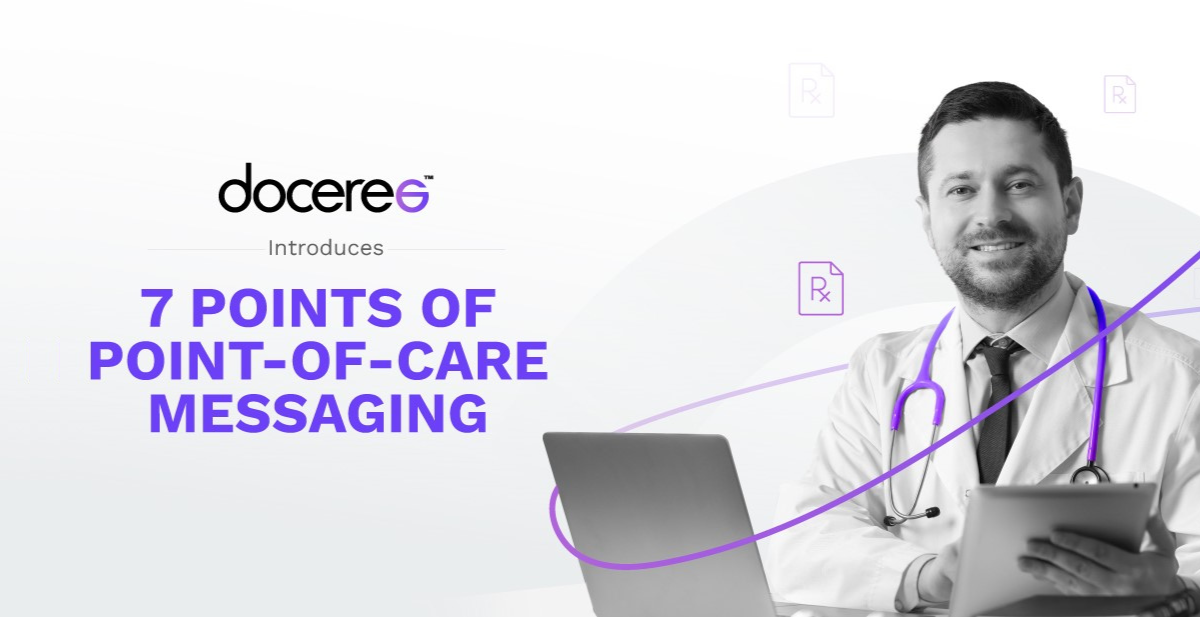
7 Game Changing Insights for Effective Point of Care Marketing - Doceree’s White Paper Breakdown
Healthcare professionals are busier than ever, spending an average of 5 hours each day navigating the EHR workflow, or roughly 16 minutes per patient. With point of care messaging platforms, such as electronic health records (EHRs), telehealth, and e-prescription, at an all-time high, cutting through the noise with targeted point of care messaging has become essential. To navigate these complexities and address emerging Healthcare Marketing Challenges in 2025, marketers must adopt forward-thinking strategies. Studies have found that most HCPs find messaging valuable only when it is directly relevant to the patients they are treating.
Doceree’s latest white paper, 7 Points of Point-of-Care Messaging: Engaging HCPs for enhanced care with targeted media strategies, explores how Point Of Care (POC) messaging insights can be leveraged to connect meaningfully with HCPs to make a real impact on patient care and foster stronger brand relationship.
The white paper underscores the importance of POC messaging as a transformative tool for healthcare marketers, enabling them to effectively elevate HCP-patient conversations. As a guide for Point of Care marketers, the white paper shatters some interesting industry myths and deep dives in the best practices of Point of care marketing.
Ideal POC Messaging Partner for maximum ROI
The ideal POC marketing partner, according to the white paper, is one that not only specializes in POC messaging capabilities and offers premium POC inventory to ensure returns on investment but is also HIPAA certified, and not just HIPAA compliant. HIPAA certification is a testament to consistent HIPAA compliance, guaranteeing the highest standards of data privacy and security.
Leveraging Contextual Power of POC Messaging to Drive Better Outcomes
The strategic placement of POC messaging on platforms where actual decision-making occurs—the bottom of the marketing funnel—when HCPs are most receptive to relevant information, gives it a unique edge over other mediums of advertising. POC platforms deliver messages to HCPs when they are diagnosing, recommending tests and procedures, and writing prescriptions. The Point of care Messaging white paper shares insights on how to maximize engagement with HCPs at various stages of their clinical workflow so as to support physicians in their clinical decision-making, reduce HCP burnout, improve delivery of patient care, apart from aiding trial recruitment and treatment affordability.
7 Points of Point-of-Care Messaging White Paper - A Strategic Guide for Healthcare Marketer
As the name suggests, the ‘7 Points of Point-of-Care Messaging’ white paper outlines seven essential insights for POC marketers in a nutshell. These insights are crafted to help pharma and life sciences marketers enhance their strategies to effectively engage HCPs on POC platforms. Each of these insights serves as a foundational element, addressing critical aspects of POC messaging that can lead to more impactful communication and improved outcomes.
The most important takeaway from the white paper is that while advertising on POC platforms, pharmaceutical and life sciences organizations must not consider it as a mere tactical media-buying tool, but a strategic brand-building exercise that nudges HCPs towards better decision-making, with valuable clinical information at crucial moments in their workflow.
The paper outlines how POC’s unique ecosystem creates a transparent and secure environment for segmenting and hypertargeting HCP population based on demographics, medical specialty, hospital affiliation, age, prescribing behavior, attitudes, history, and patient-led data to ensure that the right message is delivered to the right HCP at the right time. However, these precision-targeted messages produce desired results only when delivered within the clinical workflow at the exact moments when HCPs are diagnosing, ordering tests, or prescribing. As messages delivered on the EHR login page are not based on patient-led data, they cannot enhance engagement or drive business.
The ability of POC platforms to capture real-time clinical data benefits patients by ensuring optimum care for them. For instance, a pop-up message on EHR recommending a diagnostic test based on the patient’s medical history can assist HCPs in providing improved care. Real-time data capture capability of POC platforms also assists pharmaceutical, and life sciences organizations improve effectiveness of campaigns.
The other key insights from the white paper include how POC messaging plays a crucial role in improving health outcomes by improving treatment affordability through sharing of co-pay assistance messages to HCPs and the role it plays in facilitating patient recruitment for trials. Notably, the white paper dispels the misconception that the costs incurred in POC advertising can be prohibitive. It argues that although the cost per one-thousand impressions (CPM) may be higher on POC platforms, the cost per conversion is 17% lower on POC platforms as compared to other platforms.
The Role of Point-of-Care Messaging in Modern Healthcare Marketing
In conclusion, the ‘7 Points of Point-of-Care Messaging’ white paper offers invaluable insights into the pivotal role of POC messaging in today’s healthcare advertising landscape. This white paper serves as a crucial resource for pharmaceutical and life sciences marketers, providing the tools needed to build meaningful relationships with HCPs, improve brand recall, and drive business returns. As healthcare marketers look ahead, staying prepared for the evolving Healthcare Marketing Challenges in 2025 is essential for long-term success.
